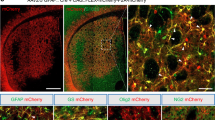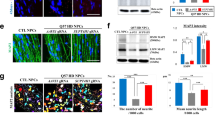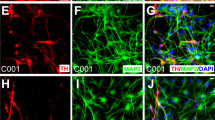Abstract
The use of stem cells for reconstructive or neuroprotective strategies can benefit from new advances in neuroimaging techniques to track grafted cells. In the present work, we analyze the potential of a neural stem cell (NSC) line, which stably expresses the glial cell line-derived neurotrophic factor (GDNF) and the firefly luciferase gene (GDNF/Luc-NSC), for cell therapy in a Huntington's disease mouse model. Our results show that detection of light photons is an effective method to quantify the proliferation rate and to characterize the migration pathways of transplanted NSCs. Intravenous administration of luciferine, the luciferase substract, into the grafted animals allowed the detection of implanted cells in real time by an optical neuroimaging methodology, overpassing the limits of serial histological analyses. We observed that transplanted GDNF/Luc-NSCs survive after grafting and expand more when transplanted in quinolinate-lesioned nude mouse striata than when transplanted in non-lesioned mice. We also demonstrate that GDNF/Luc-NSCs prevent the degeneration of striatal neurons in the excitotoxic mouse model of Huntington's disease and reduce the amphetamine-induced rotational behavior in mice bearing unilateral lesions.
This is a preview of subscription content, access via your institution
Access options
Subscribe to this journal
Receive 12 print issues and online access
$259.00 per year
only $21.58 per issue
Buy this article
- Purchase on Springer Link
- Instant access to full article PDF
Prices may be subject to local taxes which are calculated during checkout








Similar content being viewed by others
References
Arenas E . Stem cells in the treatment of Parkinson's disease. Brain Res Bull 2002; 57: 795–808.
Alberch J, Perez-Navarro E, Canals JM . Neuroprotection by neurotrophins and GDNF family members in the excitotoxic model of Huntington's disease. Brain Res Bull 2002; 57: 817–822.
Akerud P, Canals JM, Snyder EY, Arenas E . Neuroprotection through delivery of glial cell line-derived neurotrophic factor by neural stem cells in a mouse model of Parkinson's disease. J Neurosci 2001; 21: 8108–8118.
Pochon NA, Menoud A, Tseng JL, Zurn AD, Aebischer P . Neuronal GDNF expression in the adult rat nervous system identified by in situ hybridization. Eur J Neurosci 1997; 9: 463–471.
Alberch J, Perez-Navarro E, Canals JM . Neurotrophic factors in Huntington's disease. Prog Brain Res 2004; 146: 195–229.
Enomoto H . Regulation of neural development by glial cell line-derived neurotrophic factor family ligands. Anat Sci Int 2005; 80: 42–52.
Airaksinen MS, Saarma M . The GDNF family: signalling, biological functions and therapeutic value. Nat Rev Neurosci 2002; 3: 383–394.
Marco S, Canudas AM, Canals JM, Gavalda N, Perez-Navarro E, Alberch J . Excitatory amino acids differentially regulate the expression of GDNF, neurturin, and their receptors in the adult rat striatum. Exp Neurol 2002; 174: 243–252.
Perez-Navarro E, Arenas E, Reiriz J, Calvo N, Alberch J . Glial cell line-derived neurotrophic factor protects striatal calbindin-immunoreactive neurons from excitotoxic damage. Neuroscience 1996; 75: 345–352.
Perez-Navarro E, Arenas E, Marco S, Alberch J . Intrastriatal grafting of a GDNF-producing cell line protects striatonigral neurons from quinolinic acid excitotoxicity in vivo. Eur J Neurosci 1999; 11: 241–249.
Araujo DM, Hilt DC . Glial cell line-derived neurotrophic factor attenuates the excitotoxin-induced behavioral and neurochemical deficits in a rodent model of Huntington's disease. Neuroscience 1997; 81: 1099–1110.
Hoffman D, Breakefield XO, Short MP, Aebischer P . Transplantation of a polymer-encapsulated cell line genetically engineered to release NGF. Exp Neurol 1993; 122: 100–106.
Sala-Newby GB, Kendall JM, Jones H, Taylor KM, Badminton MN, Llewellyn DH, Campbell AK . Bioluminescent and chemiluminescent indicators for molecular signaling and function in living cells. In: Mason WT (ed). Fluorescent and Luminescent Probes for Biological Activity: a Practical Guide to Technology for Quantitative Real-Time Analysis (Biological Techniques). Academic Press: London, 1996, pp 58–82.
Rubio N, Villacampa MM, El HN, Blanco J . Metastatic burden in nude mice organs measured using prostate tumor PC-3 cells expressing the luciferase gene as a quantifiable tumor cell marker. Prostate 2000; 44: 133–143.
Massoud TF, Gambhir SS . Molecular imaging in living subjects: seeing fundamental biological processes in a new light. Genes Dev 2003; 17: 545–580.
El Hilali N, Rubio N, Martinez-Villacampa M, Blanco J . Combined noninvasive imaging and luminometric quantification of luciferase-labeled human prostate tumors and metastases. Lab Invest 2002; 82: 1563–1571.
Rubio N, Villacampa MM, Blanco J . Traffic to lymph nodes of PC-3 prostate tumor cells in nude mice visualized using the luciferase gene as a tumor cell marker. Lab Invest 1998; 78: 1315–1325.
Avarez-Buylla A, Garcia-Verdugo JM . Neurogenesis in adult subventricular zone. J Neurosci 2002; 22: 629–634.
Stroh A, Faber C, Neuberger T, Lorenz P, Sieland K, Jakob PM et al. In vivo detection limits of magnetically labeled embryonic stem cells in the rat brain using high-field (17.6T) magnetic resonance imaging. Neuroimage 2005; 24: 635–645.
Kostura L, Kraitchman DL, Mackay AM, Pittenger MF, Bulte JW . Feridex labeling of mesenchymal stem cells inhibits chondrogenesis but not adipogenesis or osteogenesis. NMR Biomed 2004; 17: 513–517.
Bulte JW, Kraitchman DL, Mackay AM, Pittenger MF . Chondrogenic differentiation of mesenchymal stem cells is inhibited after magnetic labeling with ferumoxides. Blood 2004; 104: 3410–3412.
Beal MF, Ferrante RJ, Swartz KJ, Kowall NW . Chronic quinolinic acid lesions in rats closely resemble Huntington's disease. J Neurosci 1991; 11: 1649–1659.
Lundberg C, Martinez-Serrano A, Cattaneo E, McKay RD, Bjorklund A . Survival, integration, and differentiation of neural stem cell lines after transplantation to the adult rat striatum. Exp Neurol 1997; 145: 342–360.
Baum C, Hegewisch-Becker S, Eckert HG, Stocking C, Ostertag W . Novel retroviral vectors for efficient expression of the multidrug resistance (mdr-1) gene in early hematopoietic cells. J Virol 1995; 69: 7541–7547.
Bosch M, Pineda JR, Sunol C, Petriz J, Cattaneo E, Alberch J et al. Induction of GABAergic phenotype in a neural stem cell line for transplantation in an excitotoxic model of Huntington's disease. Exp Neurol 2004; 190: 42–58.
Canals JM, Pineda JR, Torres-Peraza JF, Bosch M, Martin-Ibanez R, Munoz MT et al. Brain-derived neurotrophic factor regulates the onset and severity of motor dysfunction associated with enkephalinergic neuronal degeneration in Huntington's disease. J Neurosci 2004; 24: 7727–7739.
Acknowledgements
We thank M Teresa Muñoz and Ana López for technical assistance, and Dr Jaume Comas from the Cell Separation Unit of the Serveis Científico-Tècnics (Universitat de Barcelona) for their support and advice with the cell sorting procedures We thank Dr Evan Y Snyder for the generous gift of the c17.2 cell line. We are also grateful to Dr Amèrica Jiménez and the staff of the animal facility (Facultat de Medicina, Universitat de Barcelona) for their help with mice care. This study was supported by grants from the Ministerio de Educación y Ciencia (SAF2005-01335, JA; SAF2005-00147, JMC; Spain), the Ministerio de Sanidad y Consumo (Redes Temáticas de Investigación Coorporativa: G03/167 and G03/210 and FIS: PI040659; Spain), Fundació La Caixa (Spain) and the Network of excellence for Diagnostic Molecular Imaging (DiMI; Sixth Framework, European Community). JRP is a fellow from the Spanish Ministerio de Educación y Ciencia and NU is a fellow from CIRIT, Generalitat de Catalunya (Spain).
Author information
Authors and Affiliations
Corresponding author
Rights and permissions
About this article
Cite this article
Pineda, J., Rubio, N., Akerud, P. et al. Neuroprotection by GDNF-secreting stem cells in a Huntington's disease model: optical neuroimage tracking of brain-grafted cells. Gene Ther 14, 118–128 (2007). https://doi.org/10.1038/sj.gt.3302847
Received:
Revised:
Accepted:
Published:
Issue Date:
DOI: https://doi.org/10.1038/sj.gt.3302847
Keywords
This article is cited by
-
Human Umbilical Cord Matrix Stem Cells Reverse Oxidative Stress-Induced Cell Death and Ameliorate Motor Function and Striatal Atrophy in Rat Model of Huntington Disease
Neurotoxicity Research (2018)
-
Neurotrophic Factors and Their Potential Applications in Tissue Regeneration
Archivum Immunologiae et Therapiae Experimentalis (2016)
-
Huntington disease
Nature Reviews Disease Primers (2015)
-
Differentiated Mesenchymal Stem Cells for Sciatic Nerve Injury
Stem Cell Reviews and Reports (2011)
-
BDNF regulation under GFAP promoter provides engineered astrocytes as a new approach for long-term protection in Huntington's disease
Gene Therapy (2010)



